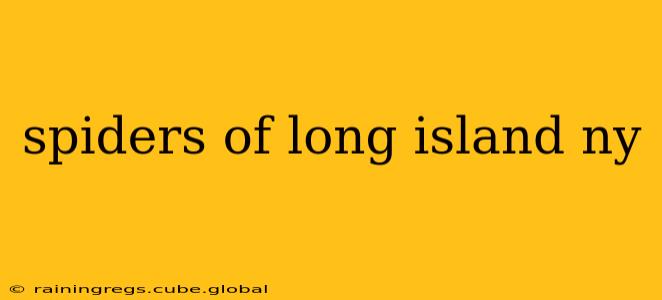Long Island, with its diverse habitats ranging from coastal beaches and marshes to suburban yards and forests, is home to a fascinating array of spider species. While most are harmless, understanding the common spiders you might encounter can ease any anxieties and help appreciate their crucial role in the ecosystem. This guide explores the common spiders of Long Island, addressing frequently asked questions to provide a comprehensive overview.
What are the most common spiders on Long Island?
Long Island boasts a rich spider diversity. Some of the most frequently encountered include:
- American House Spiders ( Parasteatoda tepidariorum): These are common in homes and often build messy, tangled webs in corners and crevices. They are small, brown, and relatively harmless.
- Orb Weavers (Family Araneidae): Many orb weaver species inhabit Long Island, creating beautiful, circular webs. They vary in size and color, but generally aren't aggressive. Common examples include various Araneus species and the strikingly patterned Argiope aurantia (Yellow Garden Spider).
- Jumping Spiders (Family Salticidae): Known for their excellent eyesight and hunting prowess, jumping spiders are small, often brightly colored, and hunt actively rather than relying solely on webs. They are fascinating to observe.
- Wolf Spiders (Family Lycosidae): These are larger, hairy spiders that are active hunters, often found roaming the ground. They typically don't build webs and carry their egg sacs. While they can bite if provoked, their venom is generally not harmful to humans.
- Cellar Spiders (Family Pholcidae): Also known as daddy longlegs spiders (though not to be confused with the harvestmen arachnids also called daddy longlegs), these are small, spindly spiders found in dark, damp places like basements and cellars. Their webs are irregular and often sticky.
Are there any poisonous spiders on Long Island?
While Long Island has a variety of spiders, the only spider considered medically significant is the Black Widow ( Latrodectus species). Black widows are identifiable by their shiny black bodies and a characteristic red hourglass marking on their abdomen. Their bite can be painful and require medical attention, but fatalities are rare. They are generally shy and avoid human contact, typically found in secluded, undisturbed areas like woodpiles and sheds. Another species of concern, although rarely encountered, is the Brown Recluse ( Loxosceles reclusa). However, Brown Recluses are not native to Long Island and sightings are extremely rare, likely misidentified spiders.
How do I get rid of spiders in my house?
Prevention is key to minimizing spider infestations. Regular cleaning, sealing cracks and crevices, and removing clutter can reduce attractive hiding spots. Vacuuming frequently helps eliminate spiders and their webs. Natural pest control methods like diatomaceous earth can also be effective, though professional pest control services might be necessary for severe infestations. Remember that spiders play an important ecological role in controlling other insects. Therefore, consider humane removal methods whenever possible.
What should I do if I get bitten by a spider?
Most spider bites on Long Island are minor and cause only mild discomfort. However, if you suspect a bite from a black widow, seek medical attention immediately. Clean the bite area with soap and water, apply a cold compress to reduce swelling, and monitor for any unusual symptoms like severe pain, nausea, or muscle cramps. Try to capture the spider if possible for identification purposes.
What kind of spider makes a spiral web?
The spiders most commonly associated with spiral or orb-shaped webs are orb-weaver spiders. These are a diverse group of spiders, and different species create webs of varying sizes and complexities.
Are spiders beneficial?
Yes! Spiders are highly beneficial to the environment. They are voracious predators that control populations of many insects considered pests, such as flies, mosquitoes, and moths. This natural pest control contributes to a healthier ecosystem.
This guide offers a basic understanding of the spiders commonly found on Long Island. For definitive species identification, consulting local entomologists or using specialized field guides is recommended. Remember that most spiders are harmless and play a vital role in the environment. Understanding them can help foster a greater appreciation for these fascinating creatures.
